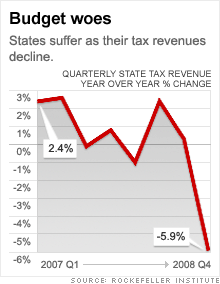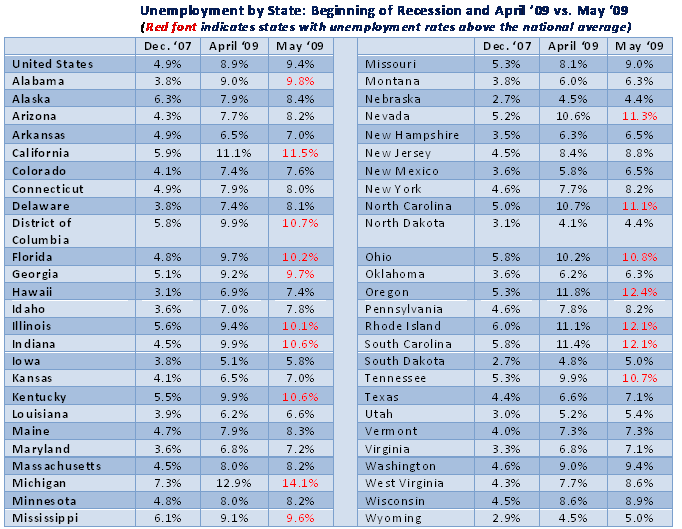What the left hand giveth (see table), the right is quickly taking away.

 To deal with these shortfalls, states have laid off or furloughed thousands of employees, raised taxes and fees, and slashed spending on education and other social programs – some, many times over. It was supposed to balance their ’09 budgets. But it wasn’t nearly enough.
To deal with these shortfalls, states have laid off or furloughed thousands of employees, raised taxes and fees, and slashed spending on education and other social programs – some, many times over. It was supposed to balance their ’09 budgets. But it wasn’t nearly enough.
For example, Ohio is expected to dip into its $948 million rainy day fund in order to deal with its worst-ever decline in tax revenue. Meanwhile, Massachusetts Gov. Deval Patrick has indicated that his state will be forced to use some of its federal stimulus money to plug a budget gap of nearly $1 billion by June 30.
The problem, of course, is that the macroeconomic effects of these micro-level policies are working at odds against the federal stimulus effort. Jobs that are being created (or saved) through the left hand of the Obama stimulus package are disappearing at least as rapidly as the right hand slashes billions from state budgets.
And, while Obama’s advisors are focused on the silver lining in the recent job data (losses are slowing), the employment picture remains bleak. The following table shows the change in unemployment rates – by state – since the start of the recession and from April ’09 to May ’09.
But Obama’s advisors may be overlooking the fact that much of the stimulus money isn’t going to be there to fund new projects and drive economic growth. This is because states like Massachusetts are diverting stimulus money away from future projects in order to cover past (2009) budget shortfalls.
And the worst may be yet to come. States are bracing for even bigger revenue shortages next year, and governors across the nation are warning of deeper cuts in fiscal 2010. And right now, no single state poses a bigger threat to the nation’s economic recovery than California.
With an estimated $24 billion budget shortfall and a July 1 deadline to close its deficit, California’s top officials asked the federal government for emergency funding to help alleviate further drastic cuts in state spending. But the president’s top economic advisors – including Treasury Secretary Timothy Geithner, and White House economists Lawrence Summers and Christina Romer – rejected Gov. Schwarzenegger’s request for aid, choosing, instead, to admonish the governor for failing to put California’s fiscal house in order.
The Washington Post reported that Gov. Schwarzenegger was denied federal assistance because White House officials feared that it would lead to “a cascade of demands from other states.” This kind of head-in-the-sand thinking will have tragic consequences.
States need more aid, and they need it now. The White House should be faced with a cascade of demands, and these demands should come from a broad coalition of governors, who storm the White House – cameras rolling – to explain the dire consequences of denying them emergency aid. Randy Wray suggested, in a previous post, that states need another $400 billion or so, and that seems like a reasonable figure. I would urge our nation’s governors to immediately request an additional $1,000 per resident.
As I have argued in a previous post, the Obama administration’s initial forecasts were far too rosy, and the Economic Recovery & Reinvestment Act didn’t provide enough aid for states. More needs to be done, and it needs to be done now. Every dollar slashed from a state budget undermines a dollar of federal stimulus spending.













4 responses to “Why The Stimulus Isn’t Working”